New Hampshire is an excellent destination for birdwatchers, with its diverse landscapes ranging from dense forests to wetlands and mountains providing habitats for different bird species.
The state’s natural environment is home to over 350 bird species, both nesting and transiting. These birds migrate to and from different regions and allow visitors to interact with unique and fascinating birds.
From songbirds to birds of prey, New Hampshire has something for everyone. This article focuses on the different bird species that inhabit New Hampshire and highlights some of the best locations to spot them.
51 Birds In New Hampshire
In the northeastern corner of the United States lies the picturesque state of New Hampshire, renowned for its stunning natural beauty and abundant wildlife.
Among its many natural treasures, the diverse avian population is a testament to the rich biodiversity within the state’s borders.
Here are 51 Birds In New Hampshire.
1. Northern Cardinal
The Northern Cardinal is a beautiful bird, easily identified by its bright red plumage. It can be found in the eastern United States from Maine to Minnesota and south through Mexico and Belize.
Along with its striking coloration, it has a distinctive crest on its head and sharp black facial markings around the eyes.
Despite their small size (7-9 inches), they are very vocal birds – males sing persistently throughout springtime to attract mates or proclaim their territory.
They typically feed on insects, seeds, and fruits but enjoy suet at backyard bird feeders.
The female is less brightly colored than her mate but still stands out among other songbirds due to her warm brownish-red feathers.
Cardinals pair for life, so you may often see them together in your garden or neighborhood park.
Scientific classification:
| Kingdom | Animalia |
| Phylum | Chordata |
| Class | Aves |
| Order | Passeriformes |
| Family | Cardinalidae |
| Genus | Cardinalis |
| Species | C. cardinalis |
Also Featured In: Most Common United States Birds, Birds for Your Home Garden
2. American Robin
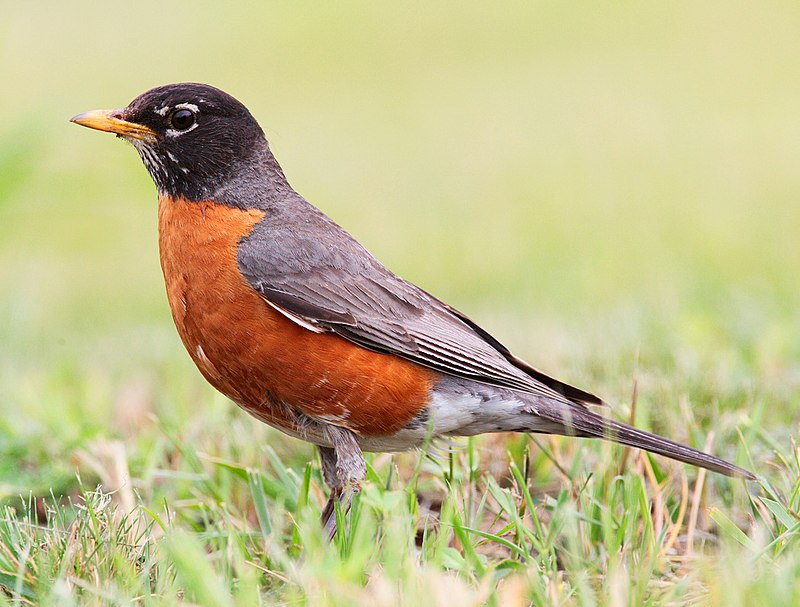
The American robin is a migratory bird belonging to the valid thrush genus and Turdidae family.
It was named after its European counterpart due to the similar reddish-orange breast they possess; however, they are not closely related.
This species can be seen through most of North America during winter months and in parts of Mexico and Central America, where it also breeds.
They have plump bodies with gray upperparts and white underparts that vary from yellow on their throats down to orange toward their bellies.
Robins feed on fruits such as berries or insects like worms, making them an essential part of ecosystems by helping disperse seeds naturally throughout these areas.
Scientific classification:
| Kingdom | Animalia |
| Phylum | Chordata |
| Class | Aves |
| Order | Passeriformes |
| Family | Turdidae |
| Genus | Turdus |
| Species | T. migratorius |
Also Featured In: Flocks Birds around Us, Blue Birds You’ll Found around Us
3. American Goldfinch
The American goldfinch is a small North American bird in the finch family. Males are vibrant yellow with black wings and tails, while females are duller in coloration.
It migrates from mid-Alberta to North Carolina during the breeding season, south of Canada–United States border to Mexico for its wintering grounds.
The only finch that undergoes complete molt every year displays sexual dichromatism, where males have brighter colors than their female counterparts.
They feed mainly on seeds but also eat insects such as aphids and caterpillars when raising young; they often occur near thistles or other plants that produce viable seed heads.
Their call consists of various chirps and trills, making them quite conspicuous.
Scientific classification:
| Kingdom | Animalia |
| Phylum | Chordata |
| Class | Aves |
| Order | Passeriformes |
| Family | Fringillidae |
| Subfamily | Carduelinae |
| Genus | Spinus |
| Species | S. tristis |
Also Featured In: Common Central Park Birds, Most Common Nature Birds
4. Black-Capped Chickadee
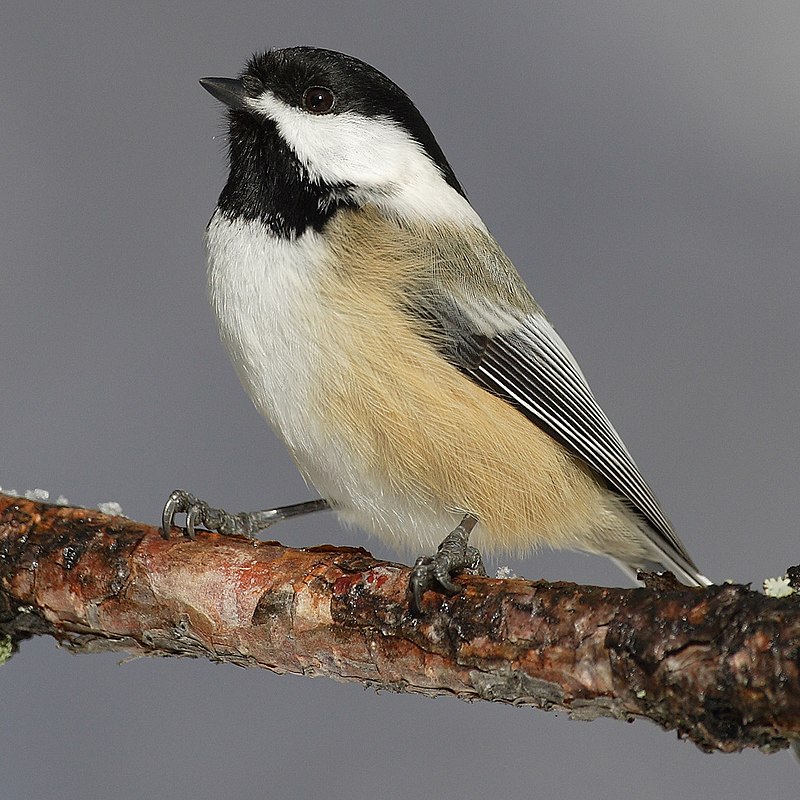
The black-capped chickadee is a small, cheerful songbird in deciduous and mixed forests across North America. It has an iconic black cap, white cheeks, gray back, and wings with whitish bars.
The underparts are usually light-colored or greyish-brown. This species is well adapted to cold winters as it can reduce its body temperature by up to 8°C while roosting at night; this helps save energy during the year’s colder months.
It feeds mainly on insects but eats seeds, fruits, and suet from bird feeders when available.
Black-capped chickadees are popular birds among backyard visitors due to their friendly nature – they often establish lifelong partnerships with one another for breeding purposes.
Furthermore, they have been designated as state birds of Massachusetts and Maine in the USA, plus New Brunswick in Canada – a testament to how beloved these little avian friends are.
Scientific classification:
| Kingdom | Animalia |
| Phylum | Chordata |
| Class | Aves |
| Order | Passeriformes |
| Family | Paridae |
| Genus | Poecile |
| Species | P. atricapillus |
Also Featured In: British Columbian Birds, Birds that Migrate through Illinois in the Spring
5. Baltimore Oriole
The Baltimore Oriole is a small, blackbird-like bird in eastern North America. It’s named for the resemblance of its male colors to those on Lord Baltimore’s coat-of-arms from the 17th century.
These birds migrate and breed during springtime and are pretty standard in their habitats.
Studies have shown that this species interbreeds with western Bullock’s orioles, classifying both as a single species – Icterus galbula.
The males typically have orange feathers along the chest, back, wings, and tail, while females display tan or yellowish shades instead of bright orange-like males.
Both sexes share white wing bars and dark brown eyes, making them easily distinguishable among other birds.
They can often be seen flitting around trees, feeding off nectar buds or insects such as grasshoppers & caterpillars they catch while flying around.
Scientific classification:
| Kingdom | Animalia |
| Phylum | Chordata |
| Class | Aves |
| Order | Passeriformes |
| Family | Icteridae |
| Genus | Icterus |
| Species | I. galbula |
Also Featured In: Birds that Calls in the Morning, Yellow Connecticut Birds
6. Blue Jay
The Blue Jay is a beautiful bird in the eastern and central United States and Newfoundland, Canada.
They have an unmistakable blue plumage with white markings on their heads and wings.
These birds are highly adaptable to habitats ranging from deciduous forests to urban areas.
As part of the Corvidae family, they are known for being intelligent problem solvers who often use tools or mimic vocalizations of other species, like hawks, when defending their territories.
Their diet consists mainly of insects, seeds, and nuts but can also include small vertebrates such as frogs or lizards if food resources become scarce.
Overall, these birds provide much-needed color to our environment while playing essential roles in maintaining healthy ecosystems through pollination services and seed dispersal activities.
Scientific classification:
| Kingdom | Animalia |
| Phylum | Chordata |
| Class | Aves |
| Order | Passeriformes |
| Family | Corvidae |
| Genus | Cyanocitta |
| Species | C. cristata |
Also Featured In: Birds of Symbolism, Spiritual Birds
7. Downy Woodpecker
The downy woodpecker is a small species of woodpecker found in North America. Growing up to 7 inches long, it can be identified by its white belly and spotted wings.
It inhabits forests throughout the United States and Canada, with the exception of deserts in the southwest and northern tundra.
This bird nests in tree cavities and feeds mostly on insects but will supplement its diet with fruit or nuts when available.
The Downy Woodpecker has an unmistakable call that sounds like a loud ‘piker,’ similar to other members of its family, such as the Hairy Woodpecker.
Scientific classification:
| Kingdom | Animalia |
| Phylum | Chordata |
| Class | Aves |
| Order | Piciformes |
| Family | Picidae |
| Genus | Dryobates |
| Species | D. pubescens |
Also Featured In: Birds in Calgary You’ll Love to See, Birds in Pacific Northwest
8. American Crow
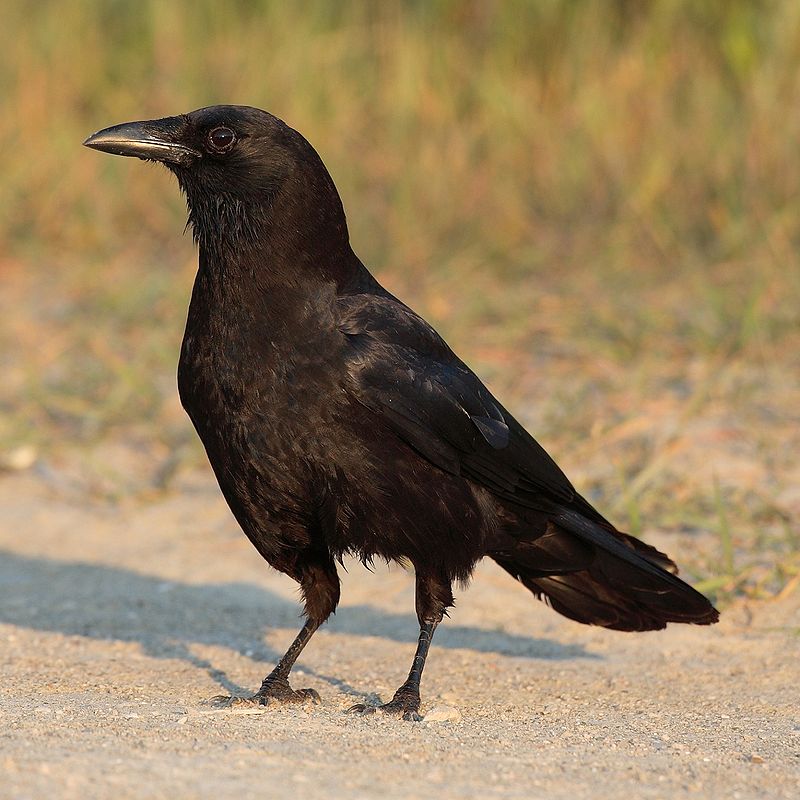
The American crow is a large bird of the Corvidae family, native to most parts of North America.
It is similar in size and structure to its European counterpart, the carrion crow and Eurasia’s hooded crow.
The three species occupy the same ecological niche but are distinguishable by their differences in appearance.
American crows have black feathers covering their entire body, with wingspans averaging between 17-21 inches wide for males and 16-19 inches for females.
They feed on insects such as grasshoppers, beetles, and caterpillars; they also eat grains from fields or abandoned farms during winter when food sources become scarcer.
In addition to feeding habits, American crows can be identified by their distinct call, which resembles a “caw” sound that travels long distances over open terrain, making them popular among birdwatchers.
Scientific classification:
| Kingdom | Animalia |
| Phylum | Chordata |
| Class | Aves |
| Order | Passeriformes |
| Family | Corvidae |
| Genus | Corvus |
| Species | C. brachyrhynchos |
Also Featured In: Birds Live Near San Diego, Scavengers Birds You Should Know
9. Red-bellied woodpecker
The Red-bellied woodpecker is a beautiful bird with an orange-red crown and nape. It breeds mainly in the eastern United States, from Florida to Canada.
This medium-sized woodpecker of the family Picidae has black wings, white stripes on its back, and tail feathers barred with black.
Its underside is primarily pale yellow or white but also has some red coloration around its neck area.
Despite this subtle red hue, it should not be mistaken for the entirely red head and neck belonging to the Red-headed woodpecker of the same genus, Melanerpes carolinus.
The Red-bellied Woodpeckers’ diet consists primarily of insects such as ants, beetles, grasshoppers, nuts, fruits, berries, and tree sap, which they will feed upon at different times throughout their life cycle.
Scientific classification:
| Kingdom | Animalia |
| Phylum | Chordata |
| Class | Aves |
| Order | Piciformes |
| Family | Picidae |
| Genus | Melanerpes |
| Species | M. carolinus |
Also Featured In Common Birds of Houston, Red Birds You’ll Commonly Found in Texas
10. House Finch
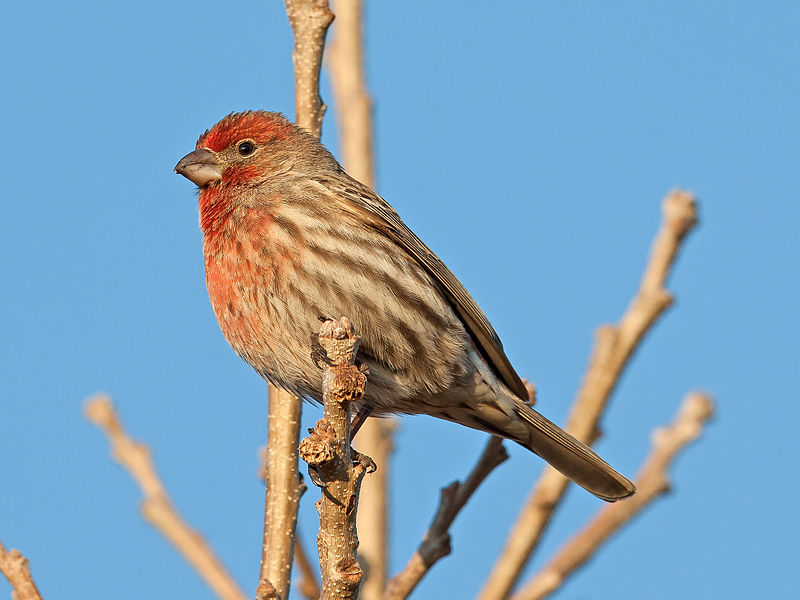
The House Finch is a finch species native to western North America and has been introduced in the eastern half of the continent and Hawaii.
It’s an average-sized finch with adults measuring 12.5 – 15 cm (5 – 6 inches) long and with a wingspan between 20 – 25 cm (8 – 10 inches).
The upperparts are brown, while its underparts range from pale grayish white to yellow depending on subspecies.
Its face is streaked or spotted with reddish coloration; males typically have brighter plumage than females due to sexual dimorphism.
They’re mostly found near human habitations such as farms and gardens, where they feed on grains, fruits, insects, etc., making them very popular among birders who want something colorful for their backyard.
Scientific classification:
| Kingdom | Animalia |
| Phylum | Chordata |
| Class | Aves |
| Order | Passeriformes |
| Family | Fringillidae |
| Subfamily | Carduelinae |
| Genus | Haemorhous |
| Species | H. mexicanus |
Also Featured In Common Birds That Live in Las Vegas, Birds That Live Around Seattle
11. Dark-Eyed Junco
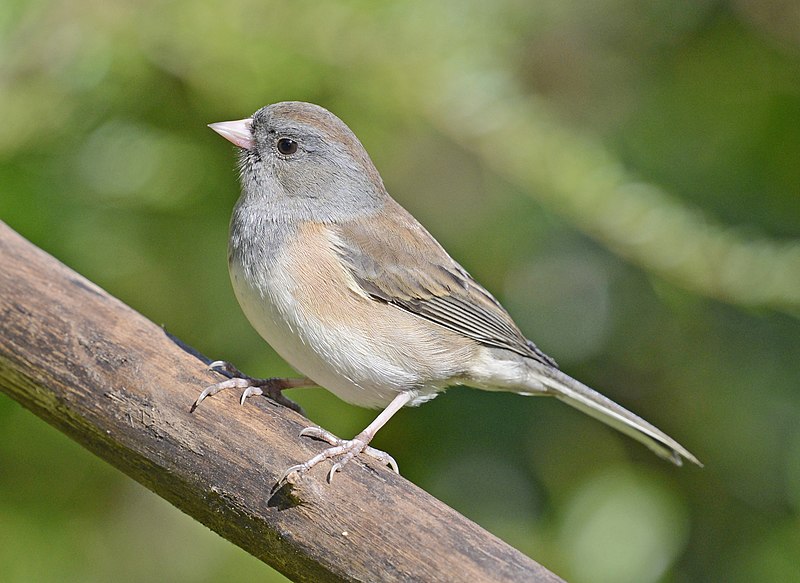
The Dark-eyed Junco is a species of small, grayish sparrows found across much of temperate North America and in the Arctic during summer.
Carl Linnaeus formally described it in 1766 and named it after its distinctive dark eyes.
This bird has a very variable appearance due to the many different subspecies it contains, making its systematics challenging to unravel.
The plumage varies from white or light gray on their underparts with slate grey backs and wings, black heads with white outer tail feathers, brown head stripes, yellow bills, pink legs, and feet, and various shades between all these colors.
They also have considerable sexual dimorphism, males tend to be more colorful than females but share similar characteristics such as short tails and rounded bodies – both sexes being around 16 cm long when fully grown.
Scientific classification:
| Kingdom | Animalia |
| Phylum | Chordata |
| Class | Aves |
| Order | Passeriformes |
| Family | Passerellidae |
| Genus | Junco |
| Species | J. hyemalis |
Also Featured In: Lake Tahoe Birds, Birds that Live in Vancouver
12. Mourning Dove
The Mourning Dove is a breathtakingly beautiful bird. It has stunning gray and brown feathers with white-tipped wings, giving it an elegant appearance. Its long tail also adds to its graceful look in flight.
A symbol of peace and serenity, they are abundant across North America and can be found in gardens or open fields throughout the year.
As well as being popular game birds for hunters, they feed on grains such as wheat and millet, providing essential food sources for wildlife species, including foxes, coyotes, skunks, and raccoons.
These doves have a distinctive cooing sound that can often echo through woodlands during summer evenings, making them one of nature’s greatest treasures.
Scientific classification:
| Kingdom | Animalia |
| Phylum | Chordata |
| Class | Aves |
| Order | Columbiformes |
| Family | Columbidae |
| Genus | Zenaida |
| Species | Z. macroura |
Also Featured In Common Species of Birds, Small Kentucky Birds
13. Tufted Titmouse
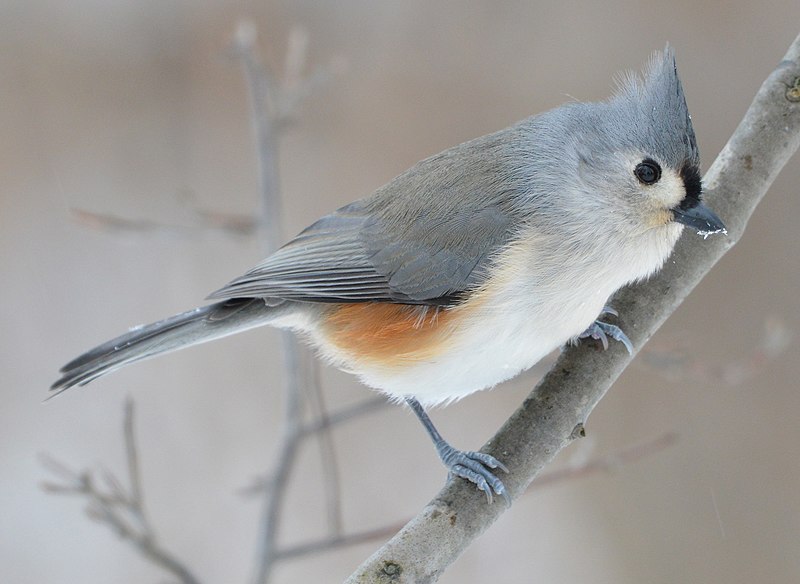
The Tufted Titmouse is a small, cheerful songbird found in North America. It’s part of the tit and chickadee family (Paridae).
It has distinctive white feathers around its eyes, grey-brown wings, and upper body, with a pale tan underside.
Its most notable feature is the black crest on top of its head, which gives it a curious look. The male also sports a pinkish breast, which can be seen.
When singing from high perches during the spring months. This bird loves to eat sunflower seeds or suet at backyard feeders and insects in summertime.
You may even see them poking into crevices and bark, looking for food.
They are exceptionally social birds, too, being often spotted in mixed flocks alongside other species, such as nuthatches and woodpeckers, all year round.
Scientific classification:
| Kingdom | Animalia |
| Phylum | Chordata |
| Class | Aves |
| Order | Passeriformes |
| Family | Paridae |
| Genus | Baeolophus |
| Species | B. bicolor |
Also Featured In Small Birds that Live in Washington D.C., Small Birds Live in Vermont
14. White-Breasted Nuthatch
The White-breasted Nuthatch is a medium-sized bird belonging to the nuthatch family Sittidae. It measures around 15.5 cm in length, and its color varies throughout its range.
Males have a light blue-grey upperpart, with a black crown and nape, whereas females have a dark grey crown instead of a black one.
The underparts are whitish, with a reddish tinge on the sides and flanks, while the bill is short and stout with a pale base near the eyes, which can be yellow or white depending on geographic location.
This species feeds mainly on insects but eats seeds, nuts, and berries when available.
They prefer open woodlands where they often climb trees searching for food along trunks and branches underneath bark crevices, creating their nest there, too.
Scientific classification:
| Kingdom | Animalia |
| Phylum | Chordata |
| Class | Aves |
| Order | Passeriformes |
| Family | Sittidae |
| Genus | Sitta |
| Species | S. carolinensis |
Also Featured In: Birds Commonly Found in Northern California, Large Birds Live in Idaho
15. Red-Winged Blackbird
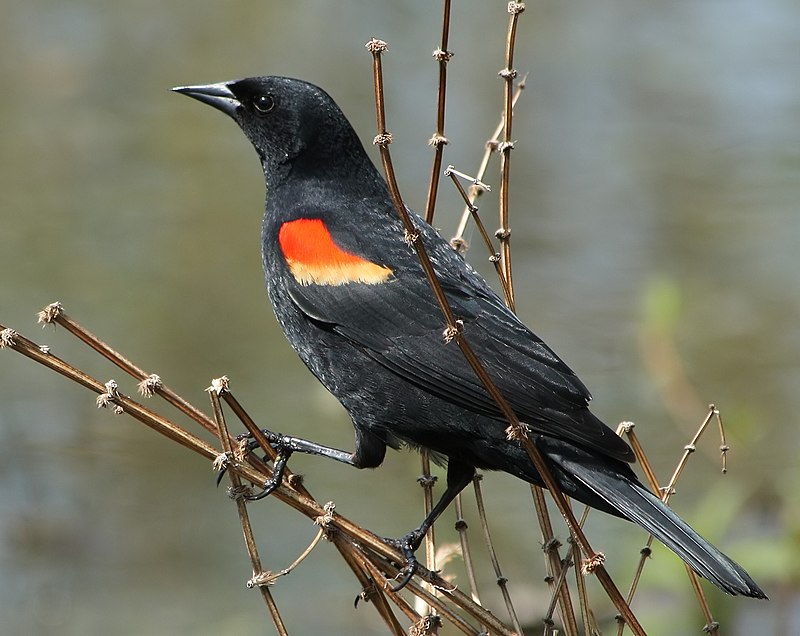
The red-winged blackbird is a beautiful bird found in most of North America and Central America.
Its distinct features include a glossy black body, white shoulder patches, and bright red wing coverts year round.
It prefers wetland habitats such as marshes, ponds, lakeshores, and agricultural fields. During breeding season, they inhabit grassy areas near water, then move south for the winter months.
For food, they mainly eat insects but also consume wild fruit or grains.
They are very social birds, often seen in large flocks during migration when their unmistakable “conk-la-ree” call can be heard echoing across the sky.
Scientific classification:
| Kingdom | Animalia |
| Phylum | Chordata |
| Class | Aves |
| Order | Passeriformes |
| Family | Icteridae |
| Genus | Agelaius |
| Species | A. phoeniceus |
Also Featured In Red birds You’ll See in Arizona, Red Minnesota Birds You Need to Know
16. Chipping Sparrow
The Chipping Sparrow is a small passerine bird found across most of North America. It has two subspecies, the eastern and western chipping sparrows, which migrate seasonally to overwinter in warmer climates.
The birds are grey above with white underparts, have a rufous cap with black stripes, and large eyes surrounded by light brown feathers.
They feed mainly on seeds but can also be seen eating insects during breeding season when raising their young chicks.
These brave little birds live in open grasslands such as prairies or meadows, building cup-shaped nests in trees or shrubs to raise their young family.
Their cheerful song often sounds like ‘chips’, hence its name: Chipping Sparrow.
Scientific classification:
| Kingdom | Animalia |
| Phylum | Chordata |
| Class | Aves |
| Order | Passeriformes |
| Family | Passerellidae |
| Genus | Spizella |
| Species | S. passerina |
Also Featured In Most Popular Bird Species in North America, Brown Birds that Live in West Virginia
17. Belted Kingfisher
The belted kingfisher is a large, eye-catching bird native to North America. It belongs to the family Alcedinidae and has been divided into three subfamilies by recent research.
The species was first described in 1758 by Carl Linnaeus in his Systema Naturae.
This water Kingfisher stands out for its size and striking plumage; males are bright blue on top with white below, and females have rusty brown backs and wings with a thick black breast band across their chest.
They also possess an impressive call that can be heard from quite far away.
Belted kingfishers feed mainly on small fish but sometimes also eat crustaceans, insects, or even amphibians if they come across them while hunting around rivers or streams.
All in all, this is truly one remarkable bird that deserves our admiration.
Scientific classification:
| Kingdom | Animalia |
| Phylum | Chordata |
| Class | Aves |
| Order | Coraciiformes |
| Family | Alcedinidae |
| Subfamily | Cerylinae |
| Genus | Megaceryle |
| Species | M. alcyon |
Also Featured In: Birds that Live around Central Florida, Birds in Surrey
18. Brown-Headed Cowbird
The Brown-headed Cowbird is a small, obligate brood parasitic icterid native to temperate and subtropical North America. It has a brown head with glossy black plumage on the body, wings, and tail feathers.
During summer, it can be found in prairies, grassland, and open wooded areas, but during winter, they migrate southwards towards the United States of Mexico for warmer climates.
They are mainly insectivorous birds that on insects like caterpillars or beetles and consume some grains.
The female bird lays its eggs in nests of other species and then incubates them until hatching time, thus leaving their chicks uncared for by themselves.
Scientific classification:
| Kingdom | Animalia |
| Phylum | Chordata |
| Class | Aves |
| Order | Passeriformes |
| Family | Icteridae |
| Genus | Molothrus |
| Species | M. ater |
Also Featured In: Birds You’ll Find in Vancouver Island, Brown Birds that are Found in Mississippi
19. Gray Catbird
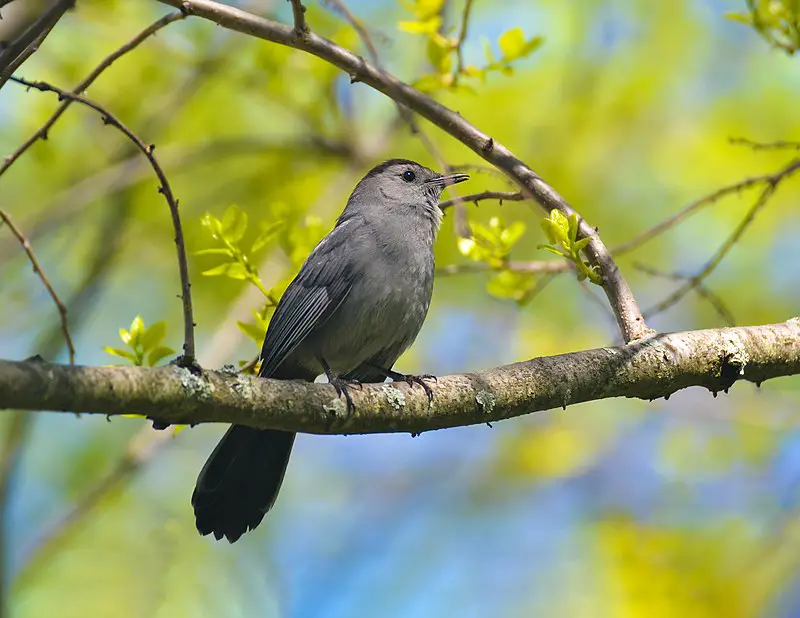
The Gray Catbird is a medium-sized bird native to North and Central America. It is the only species in its genus, Dumetella, which makes it unique among other perching birds of the Mimidae family.
Its plumage features shades of gray with some brownish tones on top and lighter grey below.
The underside of its tail has white feathers contrasting against their otherwise monochromatic coloration; this feature gives it its name as it often flicks its tail when alarmed or excited like cats do.
They are omnivorous but feed on insects such as caterpillars, grasshoppers, and beetles while eating fruits like berries or cherries during the summer.
Despite being commonly seen alone or in pairs, these birds often flock together for protection from predators like hawks, drawn to their dark coloration against green foliage, making them harder to spot.
Scientific classification:
| Kingdom | Animalia |
| Phylum | Chordata |
| Class | Aves |
| Order | Passeriformes |
| Family | Mimidae |
| Genus | Dumetella C.T. Wood, 1837 |
| Species | D. carolinensis |
Also Featured In Gray Birds that You’ll Find in Minnesota, Birds that Live in Manitoba
20. Yellow-Rumped Warbler
The Yellow-rumped Warbler (Setophaga coronata) is a migratory bird species throughout North America.
It has an extensive range, from the Pacific and Atlantic coasts of the US to Canada and Central America, with a concentration in northern areas during the breeding season.
These birds migrate southwards for wintering grounds, where they find plentiful food sources such as insects and berries.
They are easily identified by their yellow patches on either side of their tails, white underparts, gray back feathers, and two distinct crown stripes.
One black or greyish-brown above the eyes extends towards its neck and is banded in yellow or light brown.
Furthermore, these singers have strong legs, which allow them to cling to branches while hunting for prey, making them adept at maneuvering through tree cover quickly.
Altogether, this makes the Yellow-rumped Warbler an attractive backyard visitor year-round.
Scientific classification:
| Kingdom | Animalia |
| Phylum | Chordata |
| Class | Aves |
| Order | Passeriformes |
| Family | Parulidae |
| Genus | Setophaga |
| Species | S. coronata |
Also Featured In: Birds that Found in the Yellowstone, Birds that Can Be Seen in Outer Banks
21. Common Grackle
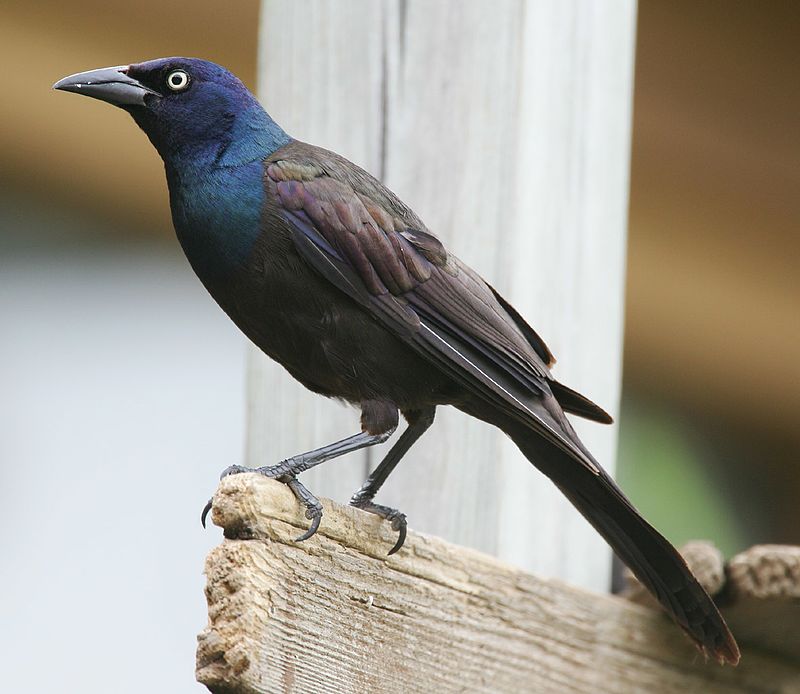
The Common Grackle is a large icterid bird commonly found in North America. It has an iridescent head and pale yellow eyes framed by its long dark bill and long tail.
Males typically have more vivid colors on their heads than females do. These birds can be seen across much of the continent, in fields, forests, wetlands – even urban areas.
They form considerable flocks to search for food, such as grains or insects, that they catch with their bills.
If available, the grackles may also scavenge from human sources like garbage dumps or picnic tables. With its colorful plumage and distinct call, it spottingasy amongst other birds.
Scientific classification:
| Kingdom | Animalia |
| Phylum | Chordata |
| Class | Aves |
| Order | Passeriformes |
| Family | Icteridae |
| Genus | Quiscalus |
| Species | Q. quiscula |
Also Featured In: Spring Birds that Live Around Us, Small Birds that Live in Michigan Birds
22. Red-Breasted Nuthatch
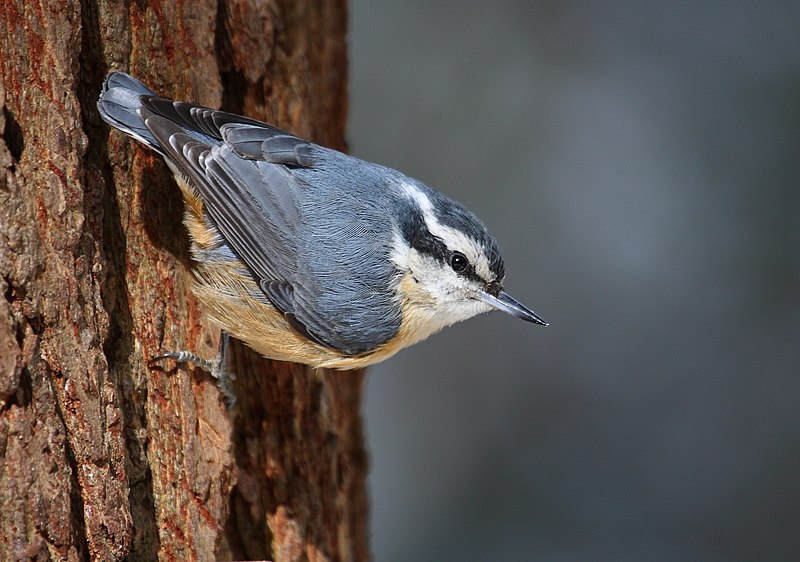
The Red-breasted Nuthatch is a beautiful and vocal songbird found in coniferous forests across Canada, Alaska, the northeastern United States, and the western US.
This small bird has blue-grey upperparts with cinnamon underparts, a white throat and face with black eye stripe, a straight grey bill, and a black crown.
Its call sounds like a tin trumpet; it’s high-pitched yet nasal.
During mating season, they form monogamous pairs to build their nest near tree trunks or branches at low heights off the ground, where they lay 2 – 8 eggs at once.
They are very active little birds who love clinging to trees while searching for insect larvae or seeds within the bark of trees, which helps control pest populations.
Scientific classification:
| Kingdom | Animalia |
| Phylum | Chordata |
| Class | Aves |
| Order | Passeriformes |
| Family | Sittidae |
| Genus | Sitta |
| Species | S. canadensis |
Also Featured In Common Birds in Canada, Adirondack Mountain Birds
23. White-Throated Sparrow
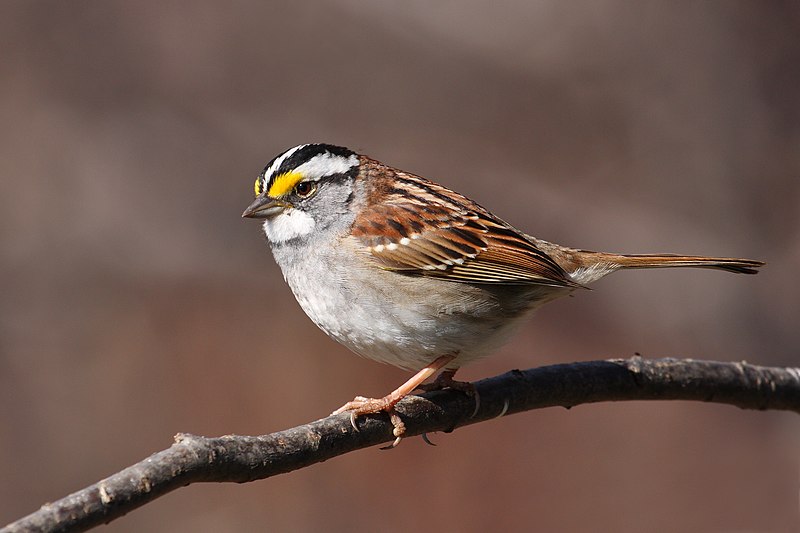
The White-throated Sparrow is a small passerine bird of the New World sparrow family, Passerellidae.
It has distinctive yellow and black stripes on its head, white throat and chest, grey back and wings, and light brown legs.
The scientific name “Zonotrichia albicollis” comes from Ancient Greek for ‘band’ (ζώνη), referring to its distinctive striped crown, and Latin for ‘white neck’ (albus collum).
These birds are usually found in wooded areas such as coniferous forests or deciduous habitats in North America, where they feed mainly on insects during the summer months, transitioning to seeds during winter.
They build their nests near ground level using grasses, twigs, or moss lined with feathers.
White-throated Sparrows may be solitary but also form flocks when migrating southward each fall season, which typically occurs over mid-late October through November, depending on location within range.
Scientific classification:
| Kingdom | Animalia |
| Phylum | Chordata |
| Class | Aves |
| Order | Passeriformes |
| Family | Passerellidae |
| Genus | Zonotrichia |
| Species | Z. albicollis |
Also Featured In: Birds of Taiga, Yellow Georgia Birds
24. Song Sparrow
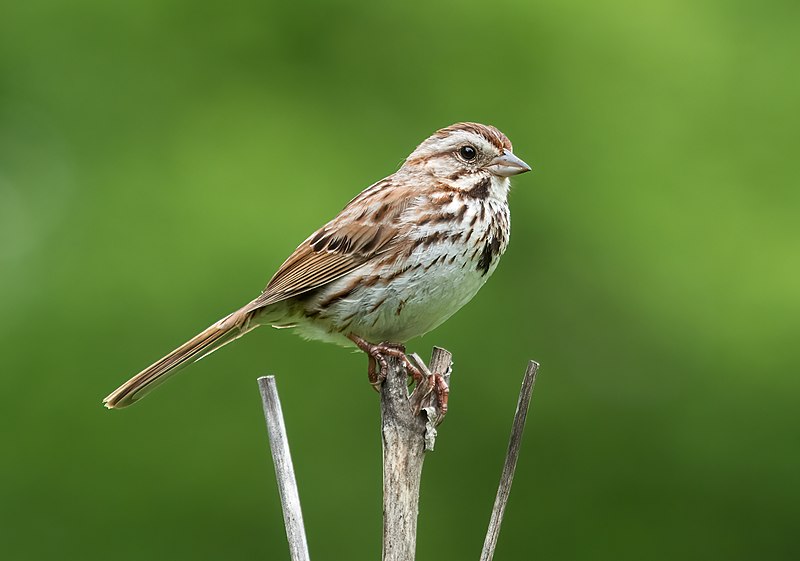
The Song Sparrow (Melospiza melodia) is a small yet abundant bird found in North America.
They have brown upperparts with dark streaks and are white underneath, complete with a distinct dark brown spot on the breast.
Their cap is also brown, and long, rough feathers can be seen sprouting from their neck area.
This sparrow species is highly variable and adaptable to many environments, including dry brush land, wetlands, or open fields.
It has been noted that adult song sparrows will sing even during winter when other birds remain quiet.
These energetic little animals make great backyard companions as they sing their lovely melodies.
Scientific classification:
| Kingdom | Animalia |
| Phylum | Chordata |
| Class | Aves |
| Order | Passeriformes |
| Family | Passerellidae |
| Genus | Melospiza |
| Species | M. melodia |
Also Featured In Brown Tennessee Birds, Common Winter Birds of New Brunswick
25. Pine Warbler
The Pine Warbler is a small New World Warbler family bird with an olive-brown upperparts and white belly.
Its distinguishing features include two white wing bars, dark legs, thin pointed bills, and yellowish ‘spectacles’ around its eyes.
Adult males have bright yellow throats and breasts on top of their olive upper parts; females and immatures are less vibrant in color but retain similar characteristics.
These birds can be found near pine forests throughout North America during the summer months before migrating to warmer climates for winter.
They feed mainly on insects such as caterpillars, spiders, and flies while consuming fruits like blueberries when food becomes scarce in colder times.
These tiny songbirds provide us with beauty through their unique plumage patterns while serving essential roles within their ecosystems.
Scientific classification:
| Kingdom | Animalia |
| Phylum | Chordata |
| Class | Aves |
| Order | Passeriformes |
| Family | Parulidae |
| Genus | Setophaga |
| Species | S. pinus |
Also Featured In: Most Common Types of Birds Found in Cuba, Yellow Birds You’ll Find in Minnesota
26. Red-Tailed Hawk
The Red-tailed Hawk is a majestic bird of prey with a distinctive red tail. It can be found throughout North America, from Alaska in the north to Panama and the West Indies in the south.
This species belongs to the Buteo genus, making it one of Earth’s most common raptorsarth.
These hawks mainly hunt small mammals such as rabbits or squirrels but also feed on reptiles and birds during migration season.
Unlike other predator birds, they prefer open areas for hunting, like fields or grasslands, rather than dense forests.
They build their nests high on trees, where they stay all year long unless humans or animals nearby disturb them.
Their presence has become an iconic part of American culture due to their frequent sightings around homes and parks alike, making them beloved creatures among people everywhere.
Scientific classification:
| Kingdom | Animalia |
| Phylum | Chordata |
| Class | Aves |
| Order | Accipitriformes |
| Family | Accipitridae |
| Genus | Buteo |
| Species | B. jamaicensis |
Also Featured In: Dominican Republic birds, Birds that Live in the Deserts
27. Ruby-Throated Hummingbird
The ruby-throated hummingbird (Archilochus colubris) is a hummingbird species with an impressive migration pattern, spending the winter in Central America, Mexico, and Florida before flying to Canada and other parts of Eastern North America for the breeding season.
It’s the most common type seen east of the Mississippi River in North America.
Formally described by Swedish naturalist Carl Linnaeus in 1758, this tiny bird has bright metallic green upperparts with white underparts, a small black bill, and a red throat patch, which gives it its name; they measure around 3 inches long on average.
They feed primarily on nectar from flowers but eat insects such as flies or mosquitoes for extra protein during their migrations or when raising young chicks.
Scientific classification:
| Kingdom | Animalia |
| Phylum | Chordata |
| Class | Aves |
| Order | Apodiformes |
| Family | Trochilidae |
| Genus | Archilochus |
| Species | A. colubris |
Also Featured In: Georgia Birds, Red Birds that Live in Tennessee
28. Eastern Phoebe
The Eastern Phoebe is a small passerine bird belonging to the genus Sayornis. It comes from Charles Lucien Bonaparte’s Muscicapa saya and Ancient Greek ornis, meaning “bird.”
The species’ alternative name ‘Phoebe’ comes from the Roman moon goddess Diana but has also been said to imitate their call.
They are up to 16 cm long with a 25–30 cm wingspan; they have grayish brown upperparts and pale underparts.
They are found near streams, woodlands, and open fields where they hunt for insects such as flies, bees, wasps, etc., often catching them midair or by sallying out from perches like branches or fences.
These birds make shallow cup nests made of grasses lined with mud-built on cliffs, ledges buildings, buildings bridges trees, etc.
This beautiful little bird is an exciting addition wherever you find it.
Scientific classification:
| Kingdom | Animalia |
| Phylum | Chordata |
| Class | Aves |
| Order | Passeriformes |
| Family | Tyrannidae |
| Genus | Sayornis |
| Species | S. phoebe |
Also Featured In: Birds that Make Mud Nests, Small Birds of Texas
29. Purple Finch
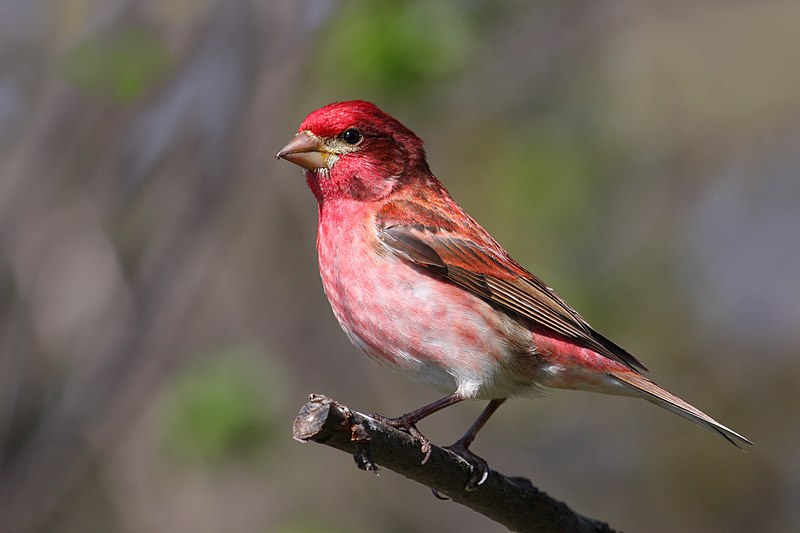
The Purple Finch is a species of finch from North America belonging to the Fringillidae family.
It’s also known as an “American Rosefinch” due to its resemblance in color and size to some European rosefinches.
Their plumage ranges from pinkish-purple on their heads and wings with a light brown underside.
Small birds measure about 5-6 inches long with short, thin beaks for eating seeds and insects.
In addition, they have thick, round bodies, which help them stay warm during cold winters in the northern parts of their range.
The Purple Finch has adapted well over time, making it easier for them to survive despite increasing threats posed by humans, such as deforestation or habitat destruction caused by development projects near their habitats.
Scientific classification:
| Kingdom | Animalia |
| Phylum | Chordata |
| Class | Aves |
| Order | Passeriformes |
| Family | Fringillidae |
| Subfamily | Carduelinae |
| Genus | Haemorhous |
| Species | H. purpureus |
Also Featured In Magenta Birds You Didn’t Know, Red Birds That Live in Kentucky
30. Eastern Screech Owl
The Eastern screech owl is a small nocturnal bird native to most wooded areas in Mexico and Canada. It has adapted well to human development, making it relatively common in East North America.
This species is known for its unique call, which sounds like a horse whinnying or an electronic beep.
Its feathers are mainly grey with brown bars, but they can also range from red-brown to blackish-grey depending on the individual bird’s location.
They feed primarily on insects and other small animals, such as mice and lizards, that live near their nest sites at night.
The eastern screech owl is a fantastic creature that adapts well to humans while staying hidden under the darkness.
Scientific classification:
| Kingdom | Animalia |
| Phylum | Chordata |
| Class | Aves |
| Order | Strigiformes |
| Family | Strigidae |
| Genus | Megascops |
| Species | M. asio |
Also Featured In: Birds You’ll Find in Zoo, Birds You’ll Find in Night
31. Scarlet Tanager
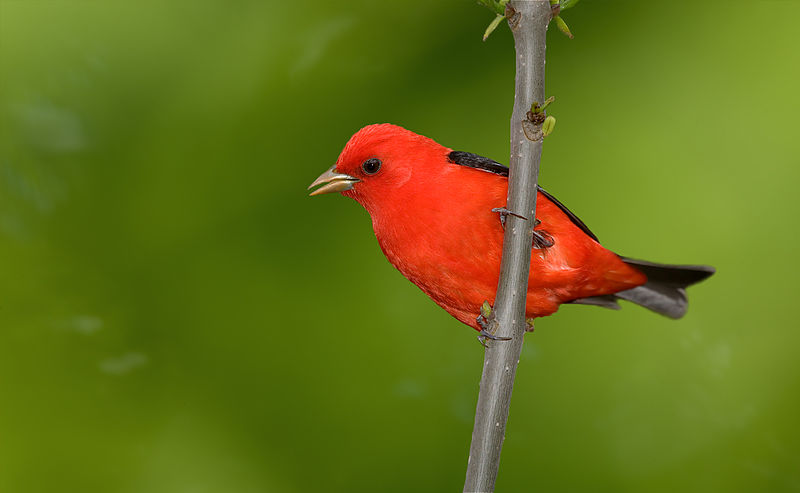
The Scarlet Tanager is a beautiful medium-sized bird in North and South America. It belongs to the Cardinal family and has striking red plumage with black wings and tail feathers.
Its song is similar to other cardinals yet also unique in its way – it’s recognizable by its high whistles that become lower towards the end.
The species feeds mainly on insects and berries from trees or shrubs during the breeding season, when they may form loose flocks over open woodlands foraging for food.
They are highly territorial birds during nesting season, between April and June each year; males and females fiercely defend their nests against intruders such as cats or squirrels.
Scientific classification:
| Kingdom | Animalia |
| Phylum | Chordata |
| Class | Aves |
| Order | Passeriformes |
| Family | Cardinalidae |
| Genus | Piranga |
| Species | P. olivacea |
Also Featured In Yellow Birds You’ll Find in North Carolina, Yellow Iowa Birds You Need to Know
32. Cooper’s Hawk
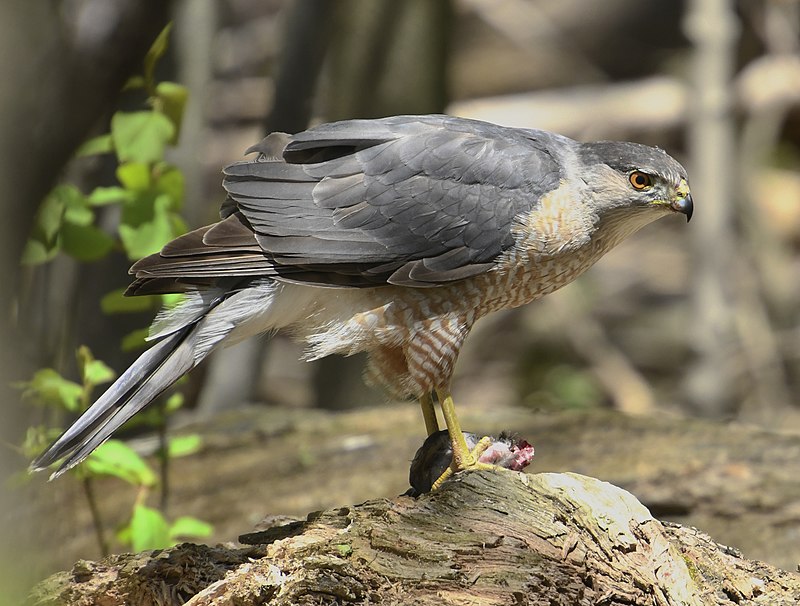
Cooper’s Hawk is a medium-sized bird of prey native to North America. It belongs to the Accipiter genus, known as its agility small size compared to other hawks.
They usually inhabit wooded areas, making them well-adapted hunters in dense environments.
Cooper’s Hawks have rounded wings with short tails that help them maneuver quickly through trees when chasing after prey, such as small rodents or birds.
These raptors also possess powerful feet equipped with sharp talons to catch food items on the ground and even out of midair.
The adult plumage has barred upperparts, ranging from greyish brown on lighter individuals to dark chestnut colors found in darker specimens; they also display rusty underparts marked by thin white streaking down either side of their chests and bellies.
Scientific classification:
| Kingdom | Animalia |
| Phylum | Chordata |
| Class | Aves |
| Order | Accipitriformes |
| Family | Accipitridae |
| Genus | Accipiter |
| Species | A. cooperii |
Also Featured In: Winter Birds of Ohio, Winter Birds of Illinois
33. House Wren
The House Wren is a small bird of the Wren family found in Canada and South America. It’s pretty standard in suburban areas and is one of the most widely distributed native birds in North and South America.
Its taxonomy can be complicated, with some subspecies groups considered separate species.
The House Wren has a brown back, grey head, white eyebrow stripes, light chestnut belly, and buffy flanks.
They often inhabit old or abandoned buildings and shrublands near fields or open woods for nesting sites.
During the breeding season, they are highly territorial, so make sure you create an inviting environment to invite them into your yard.
Scientific classification:
| Kingdom | Animalia |
| Phylum | Chordata |
| Class | Aves |
| Order | Passeriformes |
| Family | Troglodytidae |
| Genus | Troglodytes |
| Species | T. aedon |
Also Featured In: Suriname birds, House Birds You’ll Love to Pet
34. Brown Creeper
The Brown Creeper is a small songbird from the Certhiidae family and native to North America. It has brown upperparts with light spotting that resembles tree bark and white underparts.
Its bill is long and thin with a slight downward curve, while its tail is long yet stiff; this helps it creep up trees.
This bird feeds mainly on insects, found in crevices of barks or dead plants, thanks to its curved bill, which allows access to these hard-to-reach places.
When searching for food, they move diagonally upwards around trunks so their camouflage blends in perfectly with the background, making them difficult to spot.
Scientific classification:
| Kingdom | Animalia |
| Phylum | Chordata |
| Class | Aves |
| Order | Passeriformes |
| Family | Certhiidae |
| Genus | Certhia |
| Species | C. americana |
Also Featured In: Chickadees Birds, Birds in Iowa Spring
35. Common Redpoll
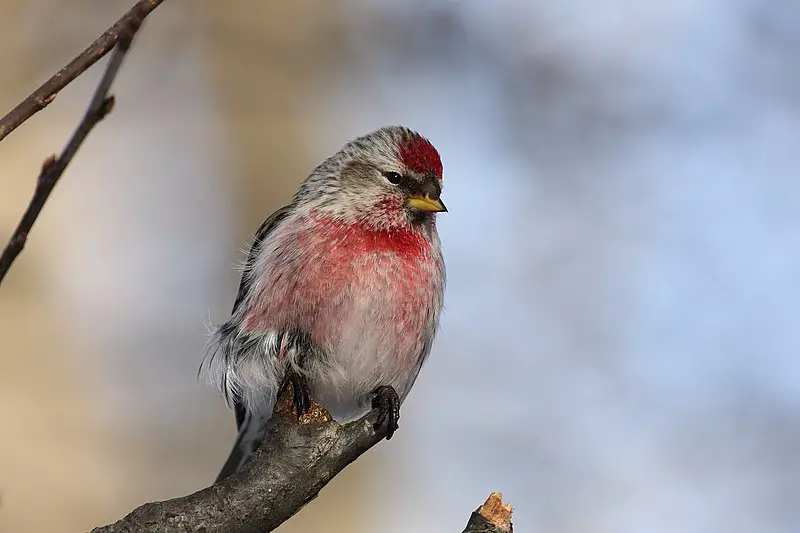
The Common Redpoll is a species of bird belonging to the finch family. It has an orange-red crown, white breast, and grey back with two black stripes running down either side.
Its wings are barred in browns, and its tail feathers have a grayish tinge at their tips. The redpoll breeds mainly south of Arctic regions in habitats that contain shrubs or thickets.
First classified by Linnaeus in 1758 under the binomial name Fringilla flammea, its genus Acanthis originates from the Ancient Greek acantha, meaning “thorn” or “prickle.”
This small yet colorful bird feeds mainly on seeds such as thistles during summer but switches to birch catkins when winter arrives – making them a common sight throughout much of North America and Eurasia.
Scientific classification:
| Kingdom | Animalia |
| Phylum | Chordata |
| Class | Aves |
| Order | Passeriformes |
| Family | Fringillidae |
| Subfamily | Carduelinae |
| Genus | Acanthis |
| Species | A. flammea |
Also Featured In: Finches Species, Most Common Winter Birds
36. Evening Grosbeak
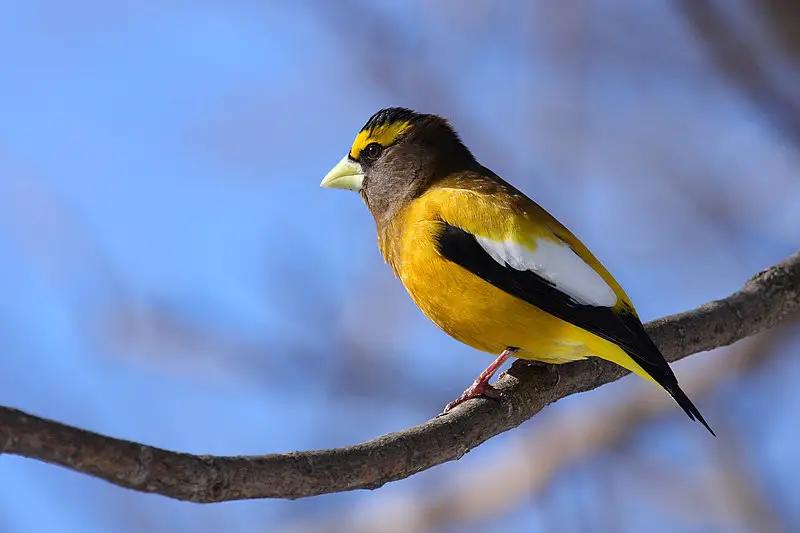
The evening grosbeak (Hesperiphona vespertina) is a beautiful passerine bird in the finch Fringillidae, native to North America.
It has an impressive wingspan of up to 20 inches, and its plumage is mostly black, yellow, or grey, with distinctive white patches on each side of its head.
Its diet consists mainly of seeds, other plant matter, and small insects, fruit, and berries when available.
The male’s song is loud and melodic, which can be heard from some distance away during breeding season, making it a widespread species for avid backyard birders.
The Evening Grosbeak typically nests high in coniferous trees, building cup-shaped structures lined with feathers or grass that protect against predators.
Overall, this species makes an excellent addition to any backyard aquarium.
Scientific classification:
| Kingdom | Animalia |
| Phylum | Chordata |
| Class | Aves |
| Order | Passeriformes |
| Family | Fringillidae |
| Subfamily | Carduelinae |
| Genus | Hesperiphona |
| Species | H. vespertina |
Also Featured In: Common Birds in Saskatchewan, Common Birds in Alberta
37. American Bittern
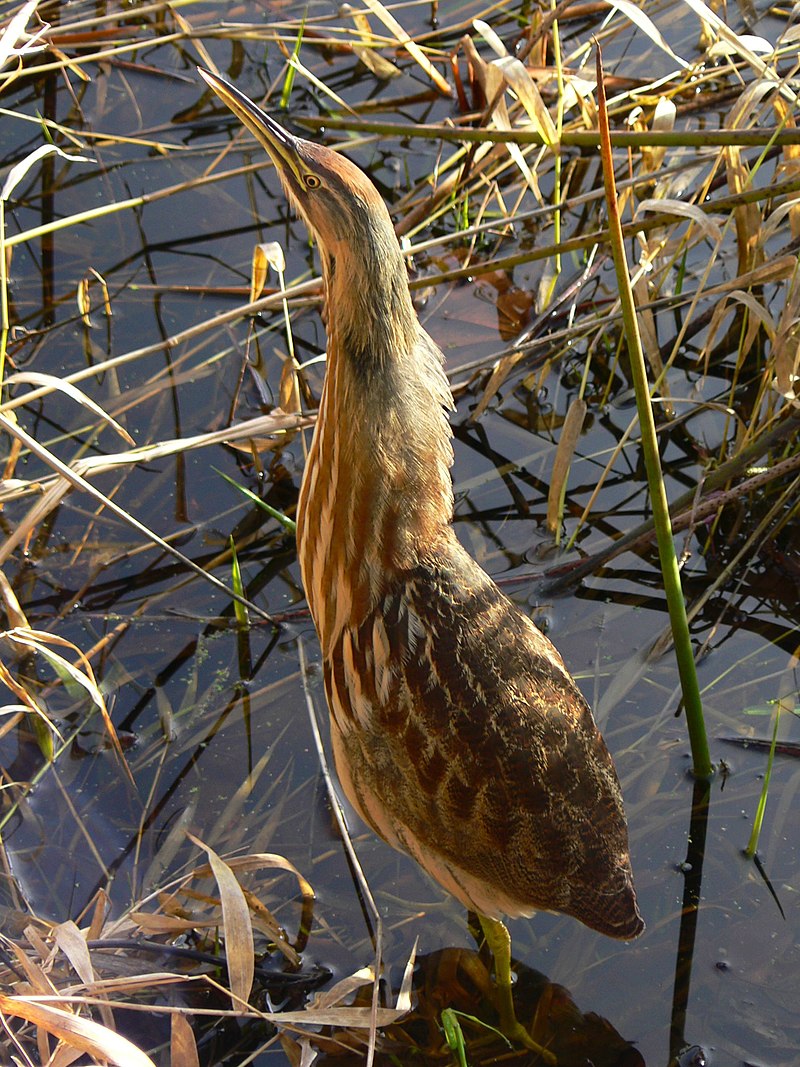
The American Bittern is a solitary, brown-wading bird from the heron family. It lives in North America and Central America, breeding in Canada and northern parts of the United States before migrating south to winter on the states surrounding the Gulf Coast and Florida’s Everglades.
Thanks to its muted coloring, it blends into its surroundings, and has a unique call that helps keep it hidden – an “un-ducklike” booming sound that can travel long distances due to low-frequency vibrations.
The bittern spends most of their time alone, Still, during mating season, they become more social while gathering together at wetlands for courtship activities such as displaying erect feathers or head bobbing.
Scientific classification:
| Kingdom | Animalia |
| Phylum | Chordata |
| Class | Aves |
| Order | Pelecaniformes |
| Family | Ardeidae |
| Genus | Botaurus |
| Species | B. lentiginosus |
Also Featured In: Herons Species, Birds That Live in Colorado
38. American Tree Sparrow
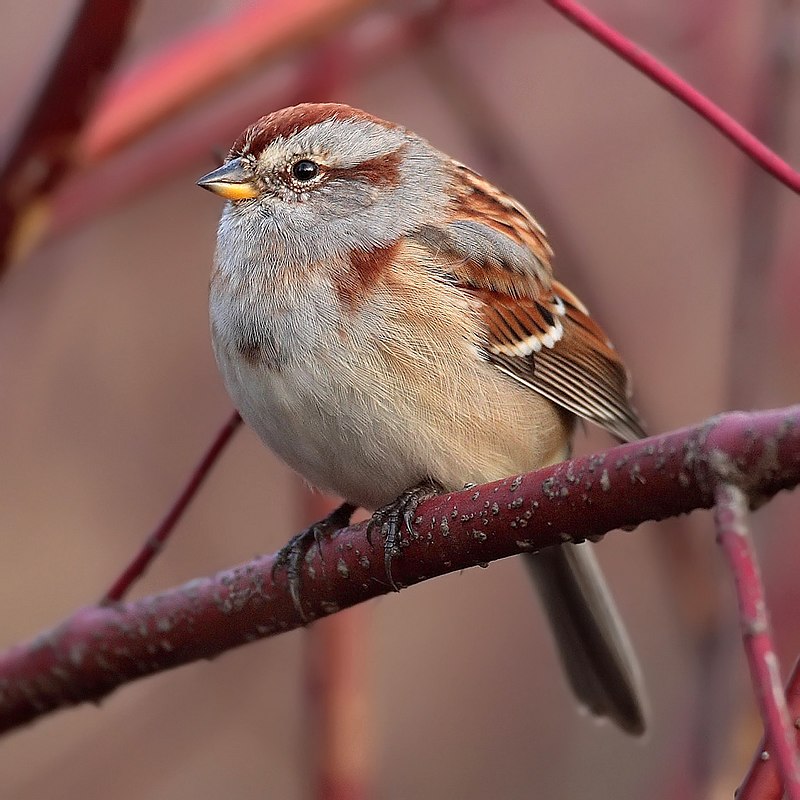
The American tree sparrow, also known as the winter sparrow, is a medium-sized New World bird. It has an attractive rusty cap, grey underparts, and a small dark spot on its chest.
Its back is rust-colored and striped with lighter shades of brown, while its wings have various shades of brown.
These birds are usually found in open areas such as grasslands or marshlands during spring migration and can form large flocks when seeking food sources like seeds, insects, or berries.
They nest in shrubs or trees near water sources but rarely do so far away from human settlements due to their dependence on supplementary foods provided by humans.
The American Tree Sparrow is a delightful sight for any nature enthusiast.
Scientific classification:
| Kingdom | Animalia |
| Phylum | Chordata |
| Class | Aves |
| Order | Passeriformes |
| Family | Passerellidae |
| Genus | Spizelloides Slager & Klicka, 2014 |
| Species | S. arborea |
Also Featured In Sparrows Species, Birds Commonly Found in New York
39. American Yellow Warbler
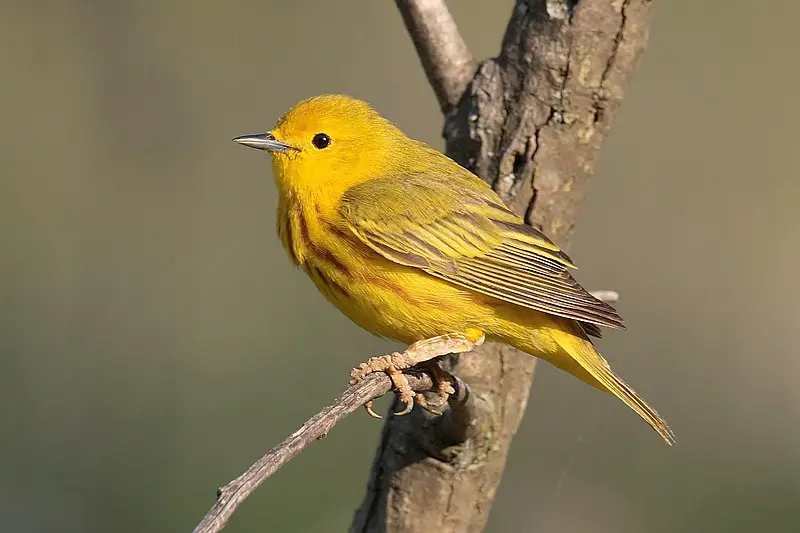
The American Yellow Warbler (Setophaga petechia) is a species of New World warbler found across North America, the Caribbean, and northern South America.
Its genus name, Setophaga, comes from Ancient Greek words meaning “moth” and “eating,” while its specific name, Petechia, originates from Italian for tiny red spots.
This bird has striking yellow plumage with reddish-brown streaks on their chest that can be seen during mating season when they are most colorful.
They live in open woodlands near wetlands or bodies of water where they can find food, such as insects like spiders, beetles, and caterpillars, which comprise much of their diet.
The male will sing to attract a mate during the breeding season before setting up a home in twig nests built by both sexes together high in trees or shrubs.
Scientific classification:
| Kingdom | Animalia |
| Phylum | Chordata |
| Class | Aves |
| Order | Passeriformes |
| Family | Parulidae |
| Genus | Setophaga |
| Species | S. petechia |
Also Featured In Utah Birds, Most Common Songs Birds that Live around You
40. Yellow-Headed Blackbird
The yellow-headed blackbird is a medium-sized bird with striking features – its head and neck are bright yellow, while the rest of its body is black.
It has large eyes, a pointed bill, and long wings that help it soar.
The species gets its name from Greek words meaning ‘yellow’ (xanthous) and ‘head’ (cephalus).
This species can be found in wetlands across North America during summer, where they feed on insects and other invertebrates such as snails, earthworms, spiders, and crustaceans.
During winter, they migrate southward for food or when temperatures drop too low for comfort.
They also form flocks, making them more visible than solitary birds like hawks or owls. Yellow-headed Blackbirds make beautiful sounds that echo around wetland areas; these melodic calls bring joy to many nature lovers.
Scientific classification:
| Kingdom | Animalia |
| Phylum | Chordata |
| Class | Aves |
| Order | Passeriformes |
| Family | Icteridae |
| Genus | Xanthocephalus Bonaparte, 1850 |
| Species | X. xanthocephalus |
Also Featured In: Birds Live in Arkansas, Summer Birds that Live around Us
41. Sharp-Shinned Hawk
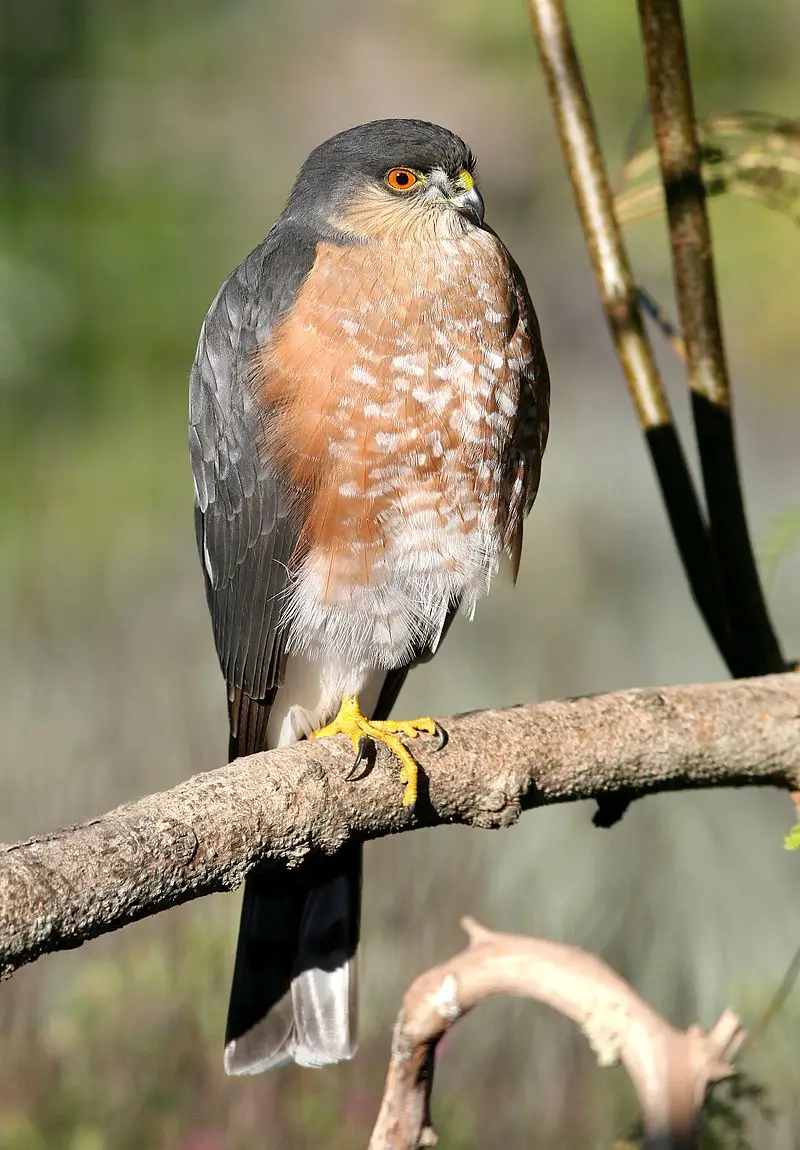
The Sharp-shinned Hawk is a small hawk found throughout the United States and Canada. It is one of the smallest hawks in North America, but larger than some Neotropical species such as the tiny hawk.
The taxonomy of this bird remains uncertain, with some authorities suggesting that southern taxa may represent three distinct species: white-breasted hawk (A. chionogaster), plain-breasted hawk (A. ventralis), and rufous morph sharp-shinned hawk (A. rufiventris).
These birds feed primarily on small birds like finches, sparrows, woodpeckers, and warblers while hunting from perches or flying through dense vegetation to surprise unsuspecting prey.
They are agile flyers that rely heavily on surprise to capture food items before they can fly away quickly.
Scientific classification:
| Kingdom | Animalia |
| Phylum | Chordata |
| Class | Aves |
| Order | Accipitriformes |
| Family | Accipitridae |
| Genus | Accipiter |
| Species | A. striatus |
Also Featured In: Common Southern Californian Birds, Most Common Lake Birds
42. Common Yellowthroat
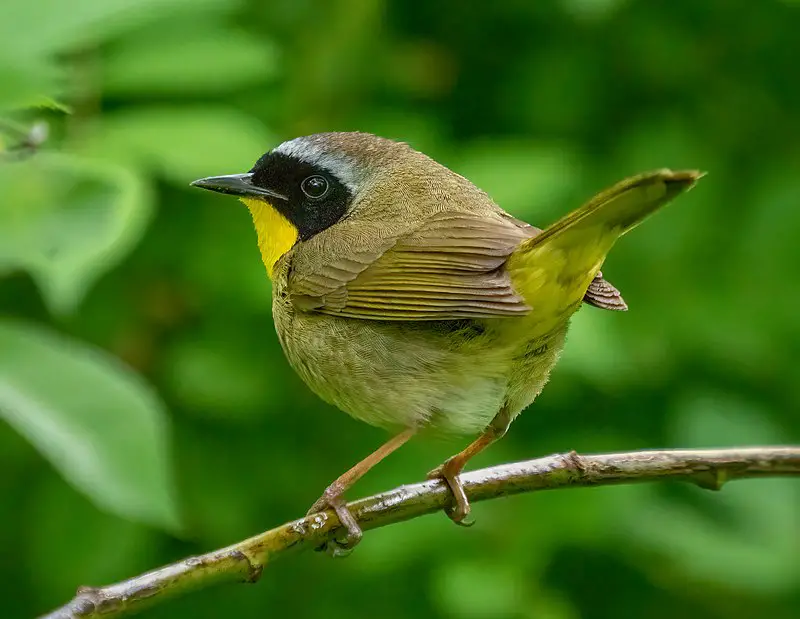
The Common Yellowthroat is a tiny New World Warbler found throughout North America. It has distinctive yellow and black plumage, earning it the nickname “Yellow Bandit” in the Midwest United States.
This species is highly adaptable and inhabits wetlands, grasslands, shrubland habitats, and suburban areas.
The genus of this bird’s scientific name means ‘ground’ and ‘small bird,’ which are fitting characteristics for such an elusive yet familiar little creature.
Its diet consists predominantly of insects but may also include other invertebrates like spiders or worms.
Overall, its cheerful song makes the Common Yellowthroat an excellent addition to any backyard.
Scientific classification:
| Kingdom | Animalia |
| Phylum | Chordata |
| Class | Aves |
| Order | Passeriformes |
| Family | Parulidae |
| Genus | Geothlypis |
| Species | G. trichas |
Also Featured In: Nebraska Birds, Wetlands Birds You Should Know
43. Rose-Breasted Grosbeak
The Rose-breasted Grosbeak is a large, brightly colored bird belonging to the Cardinal family. Males have black heads and wings, with white breasts boasting a bright rose patch.
Females are more muted in color, mostly buffy brown or greyish overall, but still featuring the distinctive rose breast patch. The two sexes also exhibit marked sexual dimorphism.
These birds inhabit open woodlands across North America, where they feed on seeds gleaned from foliage and fruits such as cherries and blueberries during their breeding season, which runs from April through August each year.
Scientific classification:
| Kingdom | Animalia |
| Phylum | Chordata |
| Class | Aves |
| Order | Passeriformes |
| Family | Cardinalidae |
| Genus | Pheucticus |
| Species | P. ludovicianus |
Also Featured In: Black And White Birds You Don’t Know About, Red Birds You’ll See in Oklahoma
44. Red-Eyed Vireo
The Red-eyed Vireo is a small American songbird that resembles singers but is not closely related to them.
It has a vast range across North America. It is considered relatively common throughout the region, with no notable threats resulting in it being classified as Least Concern on the IUCN’s red list.
Its name derives from Latin words meaning “green migratory bird,” most likely referring to female golden orioles or European greenfinches.
The species of vireos have striking plumage, including bright yellow bellies and white stripes above their eyes, which are surrounded by an orangey-red coloration – hence their namesake.
Scientific classification:
| Kingdom | Animalia |
| Phylum | Chordata |
| Class | Aves |
| Order | Passeriformes |
| Family | Vireonidae |
| Genus | Vireo |
| Species | V. olivaceus |
Also Featured In: Maine Birds, Autumn Birds You Should Know
45. Summer Tanager
The Summer Tanager is a stunningly beautiful member of the cardinal family. Native to North and South America, this medium-sized songbird features striking red plumage on its back with yellow underparts.
It has a pointed black bill and long tail feathers that can be seen fluttering through the air when it flies.
The species’ vocalizations are similar to those of other members of its genus, which often include short whistles and chirps in addition to longer songs made up of various phrases or syllables.
With their vibrant colors and melodic voices, these birds make an eye-catching sight any time they appear.
Scientific classification:
| Kingdom | Animalia |
| Phylum | Chordata |
| Class | Aves |
| Order | Passeriformes |
| Family | Cardinalidae |
| Genus | Piranga |
| Species | P. rubra |
Also Featured In: birds of Arkansas, Birds that Live in Mississippi
46. Nashville Warbler
The Nashville Warbler is a small bird found in North and Central America. It has a gray head, green back, and yellowish-white underparts.
During the breeding season, it can be seen in parts of the northern and western United States, southern Canada, and Mexico; during winter, it migrates to places like California, Texas, or further south into Central America.
Its diet consists mainly of insects, which they find by foraging on trees or shrubs near open woodlands with dense vegetation.
They are pretty active birds that move around often when searching for food, making them easy to spot if you know where to look.
Scientific classification:
| Kingdom | Animalia |
| Phylum | Chordata |
| Class | Aves |
| Order | Passeriformes |
| Family | Parulidae |
| Genus | Leiothlypis |
| Species | L. ruficapilla |
Also Featured In: birds of Kansas, Common Yellow Birds of Idaho
47. American Redstart
The American Redstart is a beautiful New World Warbler, first documented by Carl Linnaeus in 1758.
An elegant black and orange plumage sets it apart from other birds.
The genus Setophaga comes from the Ancient Greek words ‘sēs,’ meaning moth, and ‘pages,’ which means eating – referencing its insect-eating habits.
Its song is joyful, with short repeating phrases making up their melodic tune.
They are mostly found hopping around trees on their long legs during breeding season but migrate to Central America for winter months when food sources become scarce in North America.
Scientific classification:
| Kingdom | Animalia |
| Phylum | Chordata |
| Class | Aves |
| Order | Passeriformes |
| Family | Parulidae |
| Genus | Setophaga |
| Species | S. ruticilla |
Also Featured In: birds of Vermont, Acadia National Park Birds
48. Blue-Headed Vireo
The Blue-headed Vireo is a small, migratory songbird in North and Central America.
In summer, it inhabits extensive temperate forests with a mix of evergreen trees and deciduous shrubs before migrating south to warmer climates during winter.
It has two recognized subspecies: one breeds from Canada through Mexico, then down into parts of Central America, while the other resides exclusively in Cuba.
Its feathers are predominantly olive green with white underparts and wings marked by yellowish edges on its primary coverts.
The most distinguishing feature, however, is its bright blue head, which explains why it’s named after this characteristic trait.
Scientific classification:
| Kingdom | Animalia |
| Phylum | Chordata |
| Class | Aves |
| Order | Passeriformes |
| Family | Vireonidae |
| Genus | Vireo |
| Species | V. solitarius |
Also Featured In: birds of Mississippi, Common Vermont Winter Birds
49. Magnolia Warbler
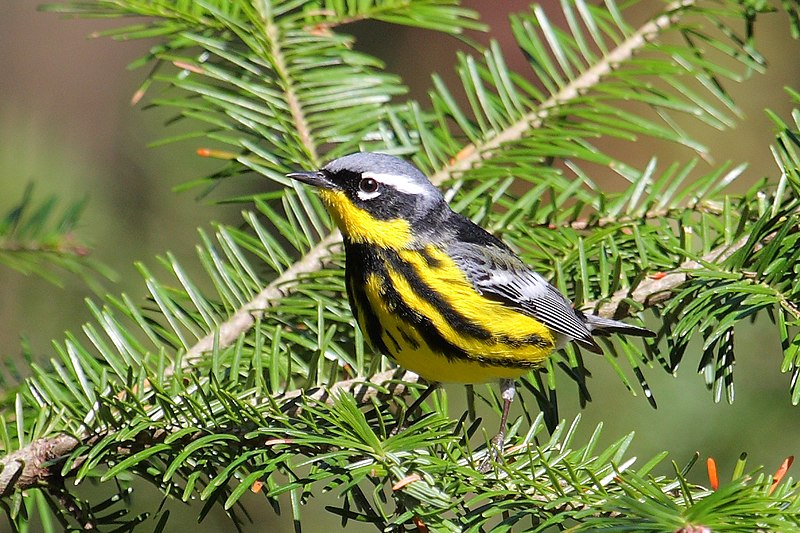
The Magnolia Warbler is a small and beautiful bird native to North America. It belongs to the wood warbler family of Parulidae, and its name derives from the type locality Fort Adams, Mississippi, where Alexander Wilson first discovered it.
This species has an overall length of 4 – 5 inches, with a wingspan measuring 6-7 inches long.
Its plumage consists of a yellow chest, which turns olive green on top, its underside takes a white hue, and its throat remains black in coloration, along with two white wing bars on either side.
Regarding diet, they feed mainly on insects like caterpillars, moths, etc., but also feed on fruits or seeds occasionally during the winter and migratory periods.
Scientific classification:
| Kingdom | Animalia |
| Phylum | Chordata |
| Class | Aves |
| Order | Passeriformes |
| Family | Parulidae |
| Genus | Setophaga |
| Species | S. magnolia |
Also Featured In: birds of yellow birds, Birds of Nova Scotia
50. Northern Flicker
The Northern flicker is a woodpecker species found in North America, Central America, Cuba, and the Cayman Islands. This medium-sized bird is known for its unique migration behavior.
Over 100 common names refer to the Northern Flicker, one of them being “yellowhammer.” It is a beautiful bird with distinctive markings and colorful plumage.
The Northern flicker is an essential species in its ecosystem and is crucial in maintaining a healthy environmental balance.
Despite being a woodpecker, the Northern Flicker has a diverse diet, including insects, fruits, and seeds.
Observing this bird as it pecks at trees for food, communicates with its unique vocalizations, and performs its incredible aerial displays is fascinating.
The Northern flicker is ely a remarkable bird worthy of our admiration and protection.
Scientific classification:
| Kingdom | Animalia |
| Phylum | Chordata |
| Class | Aves |
| Order | Piciformes |
| Family | Picidae |
| Genus | Colaptes |
| Species | C. auratus |
Also Featured In: Common Birds in the Cities, Long Island Birds You Should Know
51. Cedar Waxwing
The Cedar waxwing, also known as Bombycilla cedrorum, is a medium-sized bird in North and Central America.
Their body has a mixture of brown, gray, and yellow feathers, and their wings have wax-like tips.
These birds prefer open wooded areas in Southern Canada for breeding, and during winter, they migrate to the Southern part of the United States, Central America, and the far.
The Cedar waxwing is a member of the waxwing family of birds or Bombycillidae family.
They are known for their distinctive crest on their head and a black mask-like area around their eyes.
These birds are social creatures and can often be seen in large flocks, sometimes even intermixing with other bird species.
Their diet consists mainly of fruit and insects, essential fruit seed dispersers.
The Cedar waxwing bird is a beautiful and fascinating creature to observe in the wild.
Scientific classification:
| Kingdom | Animalia |
| Phylum | Chordata |
| Class | Aves |
| Order | Passeriformes |
| Family | Bombycillidae |
| Genus | Bombycilla |
| Species | B. cedrorum |
Also Featured In: Central Texas Birds, Birds that Live in San Francisco Bay Area
Conclusion
New Hampshire’s diverse habitats support various bird species, contributing to the state’s ecological balance and natural beauty.
From the iconic Common Loon to the majestic Bald Eagle and the vibrant American Goldfinch, these 51 birds represent just a fraction of the avian diversity found in the Granite State.
Understanding and appreciating these birds is essential for their conservation and fostering a deeper connection to New Hampshire’s rich natural heritage.